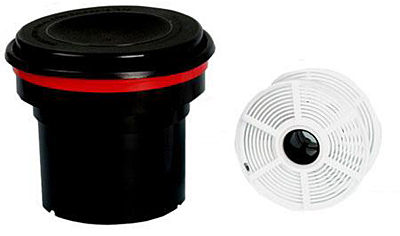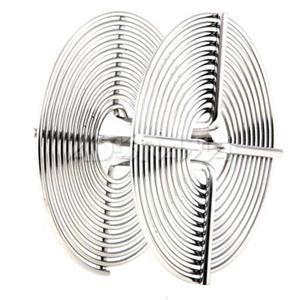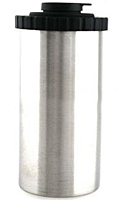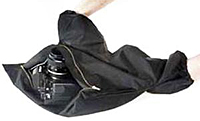

Leave a Comment!
How To Develop Black and White Film At Home Like A Pro
You've built a darkroom. You've taken the pictures. Now it's time to learn black and white film developing. Here's my 12-step program, part 1:
Why do black and white film processing instead of sending it to a lab? First off, there aren't many labs that handle black and white film processing and printing any more, and those that do are, frankly, expensive. If you're committed to film, go all the way and soup it yourself.
By the time you finish this column, you'll be an expert in the basics of black and white film developing (assuming you read it diligently and practice, practice, practice). Print it out and paste it over your film processing workspace for handy reference.
Black and White Film Processing Buying Guide: Everything You Need for Steps 1-3

A film developing tank. Metal or Plastic?
Plastic: For some, rolling film onto a plastic tank reel is easier, and for those, I recommend the Adorama Ultra Universal Plastic Daylight Film Developing Tank, which can accomodate two rolls of 35mm, or one roll of either 120 and 220 rollfilm. The Paterson 35mm Tank and Reel lets you develop one roll at a time, but if you shoot a lot, you may want the 3-reel or 5-reel tank.

 Stainless Steel: With a little practice, loading film onto a stainless steel reel is a cinch. Yes, you could save money by buying cheaper ones but they're harder to use. I recommend the Hewes Heavy Duty Stainless Steel Film Developing Reels for 35mm or 120/220 rollfilm, and the Adorama Stainless Steel Daylight Film Developing Tank, which is available in one, two, four, or eight rolls of 35mm and half that many rolls of roll film. Keep in mind the reels and tanks are sold separately.
Stainless Steel: With a little practice, loading film onto a stainless steel reel is a cinch. Yes, you could save money by buying cheaper ones but they're harder to use. I recommend the Hewes Heavy Duty Stainless Steel Film Developing Reels for 35mm or 120/220 rollfilm, and the Adorama Stainless Steel Daylight Film Developing Tank, which is available in one, two, four, or eight rolls of 35mm and half that many rolls of roll film. Keep in mind the reels and tanks are sold separately.
 A pitch-black room...or a changing bag: If you have your own indoor room with absolutely no light leaking in (turn the light off and stand there for a few minutes. If you see any light, it's not light tight.) Don't have a pitch-black room? No worries. A roomy film changing bag is a portable light-tight solution. The Adorama Large Changing Bag, at 27x30 inches, is roomy enough. Besides, if you decide to bulk-load your film to save money, you can do it in here. The best part? While the film is in total darkness, you can sit in a lit room.
A pitch-black room...or a changing bag: If you have your own indoor room with absolutely no light leaking in (turn the light off and stand there for a few minutes. If you see any light, it's not light tight.) Don't have a pitch-black room? No worries. A roomy film changing bag is a portable light-tight solution. The Adorama Large Changing Bag, at 27x30 inches, is roomy enough. Besides, if you decide to bulk-load your film to save money, you can do it in here. The best part? While the film is in total darkness, you can sit in a lit room.
Something to open the film with: I recommend a bottle opener. Buy one at your local convenience store, or get a spare from your kitchen. I've been using the same cheap bottle opener since the 70s.
How to Develop A Roll of Black-and-White Film
First, you need to load the film onto a reel and place it in the tank. A straightforward sounding affair. Until you learn that it must be done blind.Lay out your tools in front of you: film cassette, can opener, film reel, tank and tank cover. Memorize their positions. Turn off the light (or zip the bag closed). You're ready.
Step 1: In total darkness, remove the film from the cassette. Pull the flat end (as opposed to the end with the tip of the spool sticking out) off the 35mm canister with a can opener. Unwind the film and remove the end of the film from the spool by peeling off the tape that connects it.
Step 2: Load the film onto either a metal or plastic film reel. For beginners, plastic may be easier to learn than metal. With plastic, you simply slide one end of the film into a slot on the outer edge of the reel and "walk" the film in until it is loaded. Metal demands a higher degree of dexterity, which might not be appreciated when you're standing in the dark struggling to get your valuable shots onto the reel.
Tip: Following the instructions that come with the tank, practice loading a few times with a sacrafical roll in daylight so you can see and get the feel for it. Once you feel competent in daylight, close your eyes and try it. You'll fumble. You'll fume. Keep trying. You'll get it, eventually.
Step 3: Place the loaded reel in the film tank ad cover it as directed. The film is now in a light tight container. You can turn on the light or take the closed tank out of the changing bag.
Tip: The first roll you actually try to develop should not have important material on it, just in case things don't quite work out. This way you can learn from your mistakes with minimal stress.
It's time to bring on the chemistry!
1 | 2 | 3
Leave a comment!
8 35mm ISO 400 Black & White Films Compared!
The right formula:
7 Top Black and White Film Developers
This is an ad: